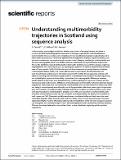Understanding multimorbidity trajectories in Scotland using sequence analysis
Abstract
Understanding how multiple conditions develop over time is of growing interest, but there is currently limited methodological development on the topic, especially in understanding how multimorbidity (the co-existence of at least two chronic conditions) develops longitudinally and in which order diseases occur. We aim to describe how a longitudinal method, sequence analysis, can be used to understand the sequencing of common chronic diseases that lead to multimorbidity and the socio-demographic factors and health outcomes associated with typical disease trajectories. We use the Scottish Longitudinal Study (SLS) linking the Scottish census 2001 to disease registries, hospitalisation and mortality records. SLS participants aged 40–74 years at baseline were followed over a 10-year period (2001–2011) for the onset of three commonly occurring diseases: diabetes, cardiovascular disease (CVD), and cancer. We focused on participants who transitioned to at least two of these conditions over the follow-up period (N = 6300). We use sequence analysis with optimal matching and hierarchical cluster analysis to understand the process of disease sequencing and to distinguish typical multimorbidity trajectories. Socio-demographic differences between specific disease trajectories were evaluated using multinomial logistic regression. Poisson and Cox regressions were used to assess differences in hospitalisation and mortality outcomes between typical trajectories. Individuals who transitioned to multimorbidity over 10 years were more likely to be older and living in more deprived areas than the rest of the population. We found seven typical trajectories: later fast transition to multimorbidity, CVD start with slow transition to multimorbidity, cancer start with slow transition to multimorbidity, diabetes start with slow transition to multimorbidity, fast transition to both diabetes and CVD, fast transition to multimorbidity and death, fast transition to both cancer and CVD. Those who quickly transitioned to multimorbidity and death were the most vulnerable, typically older, less educated, and more likely to live in more deprived areas. They also experienced higher number of hospitalisations and overnight stays while still alive. Sequence analysis can strengthen our understanding of typical disease trajectories when considering a few key diseases. This may have implications for more active clinical review of patients beginning quick transition trajectories.
Citation
Cezard , G I , Sullivan , F & Keenan , K L 2022 , ' Understanding multimorbidity trajectories in Scotland using sequence analysis ' , Scientific Reports , vol. 12 , 16485 . https://doi.org/10.1038/s41598-022-20546-4
Publication
Scientific Reports
Status
Peer reviewed
ISSN
2045-2322Type
Journal article
Description
Funding information: This work was supported by the Academy of Medical Sciences, the Wellcome Trust, the Government Department of Business, Energy and Industrial Strategy, the British Heart Foundation Diabetes UK, and the Global Challenges Research Fund [Grant number SBF004\1093 awarded to Katherine Keenan].Collections
Items in the St Andrews Research Repository are protected by copyright, with all rights reserved, unless otherwise indicated.

